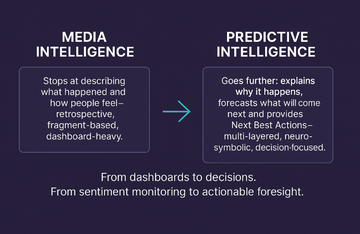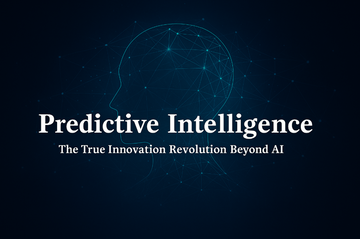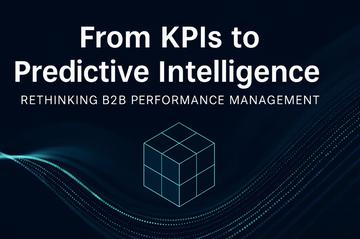Media Intelligence vs. Predictive Intelligence: Why the Future of Corporate Communication Demands a Shift
by Uwe Seebacher on Sep 19, 2025

By Prof. Dr. Uwe Seebacher
Structural and Methods Scientist | International Faculty | Thought Leader on Predictive Strategy and Post-Growth Transformation
Introduction
For over a decade, Media Intelligence (MI) has been the backbone of Corporate Communication. Dashboards, sentiment analyses, and social listening tools promised to make complex media landscapes understandable. And in many ways, they delivered: MI systems gave communication experts access to real-time insights into brand perception, sentiment shifts, and competitive benchmarks.
But in 2025, one thing has become clear: Media Intelligence has reached its limits.
Today, communication leaders face an overwhelming challenge:
-
Data is everywhere, yet clarity is rare.
-
Dashboards multiply, but actionable recommendations remain scarce.
-
We measure sentiment, but we rarely understand its causes.
This is where Predictive Intelligence (PI) marks the turning point.
The Limits of Media Intelligence
Media Intelligence – no matter how advanced or AI-powered – remains retrospective. It tells you what happened and sometimes how people feel about it. But it rarely explains why these reactions occur, nor what you should do next.
MI works primarily on a fragment level:
-
A tweet is classified as negative.
-
An article is categorized as critical.
-
A post is flagged as influential.
This is valuable, but it remains descriptive. Communication leaders are left to connect the dots themselves, often under time pressure, with incomplete context.
Predictive Intelligence: Moving Beyond Description
Predictive Intelligence is not just the next step – it’s a paradigm shift.
Where MI stops at sentiment recognition, PI uncovers the drivers behind sentiment and forecasts how these dynamics are likely to evolve. It combines:
-
Neural Pattern Learning (detecting real-time shifts in emotions and discourse).
-
Symbolic Knowledge Bases (contextualizing with past crises, cultural dynamics, and communication theory).
-
Multi-layer Analysis (medium → content segments → micro-messages).
This neuro-symbolic approach enables PI not only to detect that a debate is turning negative, but also why, and most importantly, what to do next.

Fig. 1: Media Intelligence vs. Predictive Intelligence
(Source: own illustration)
From Dashboards to Decisions
Think of the difference this way:
-
Media Intelligence is like watching yesterday’s weather report. You know it rained, you see the storm clouds, and you note people are unhappy.
-
Predictive Intelligence is like having a weather model that not only predicts the next storm but also tells you which neighborhoods will flood, what resources you’ll need, and how to mitigate damage.
For Corporate Communication, this means:
-
From sentiment to causality: not just what people feel, but why they feel it.
-
From monitoring to action: not just dashboards, but Next Best Actions (NBAs).
-
From data to dialogue: empowering communication teams to respond proactively rather than reactively.
Why Corporate Communication Leaders Must Switch Now
The communication environment is more volatile than ever: geopolitical uncertainty, stakeholder activism, AI-driven misinformation. Relying on descriptive dashboards is no longer enough.
Corporate Communication experts who continue to operate with MI alone risk:
-
Decision fatigue – too much data, too little clarity.
-
Attribution gaps – sentiment shifts without knowing the drivers.
-
Lost trust – being reactive instead of leading the conversation.
By contrast, organizations adopting PI gain:
-
Strategic foresight – anticipating crises before they escalate.
-
Clarity in complexity – understanding why perceptions shift.
-
Proactive communication – moving from monitoring to orchestrating stakeholder dialogues.
The Road Ahead
Predictive Intelligence is not here to replace communication leaders – it is here to empower them.
It doesn’t drown teams in dashboards, but instead focuses attention on the few insights that matter most. It doesn’t just highlight problems, but proposes solutions.
For Corporate Communication experts accustomed to Media Intelligence, the question is no longer if you should make the switch, but when. Those who embrace PI now will define the future of communication. Those who don’t risk being stuck in an outdated, descriptive mode while competitors move ahead with foresight and agility.
Final Thought
Media Intelligence showed us the “what.” Predictive Intelligence reveals the “why” – and guides us to the “what next.”
The future of Corporate Communication lies not in monitoring the past, but in anticipating and shaping the future.
📩 If you want to learn more about Predictive Intelligence in Corporate Communication, research partnerships are open at the Academic Institute for Qualified Methods and Professional Structures (AQPS).
Get in touch at hello@aqps.eu with the subject line “Predictive Intelligence for Communication”.




